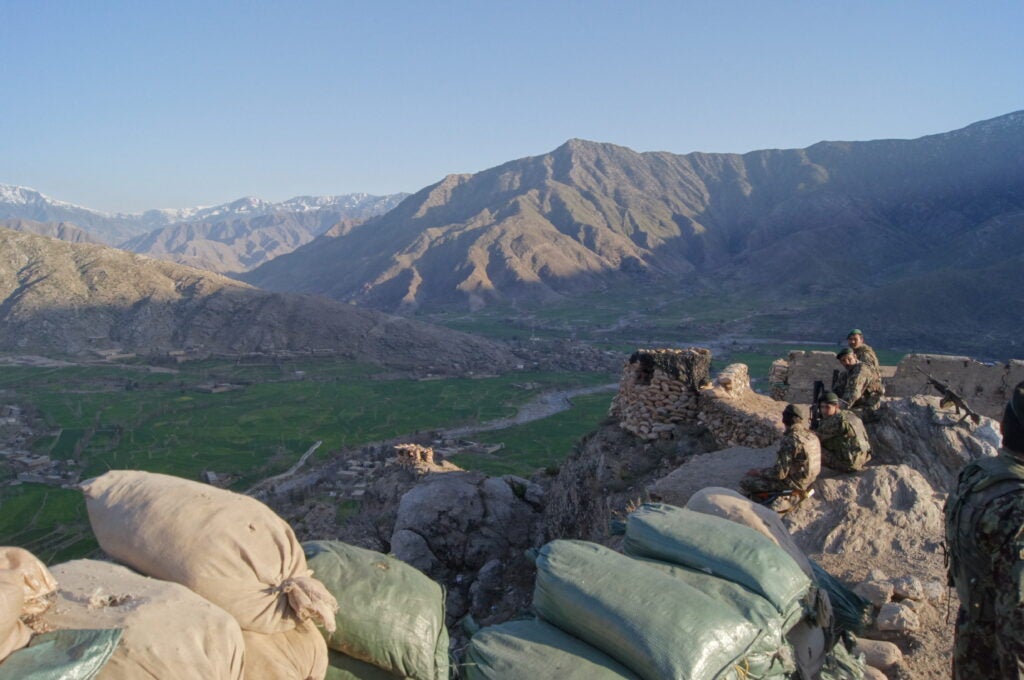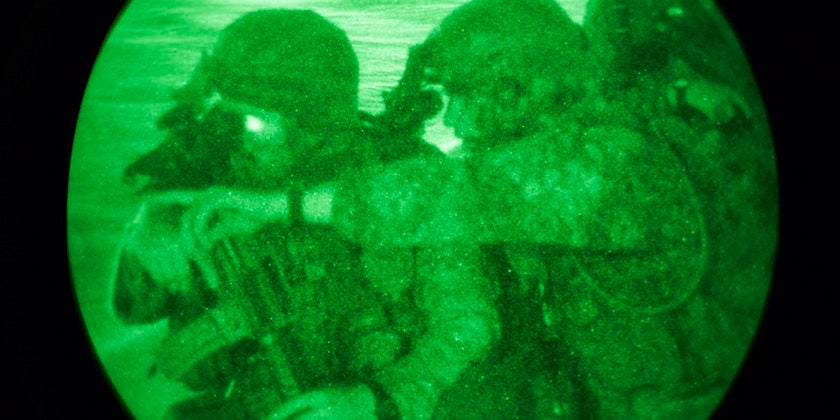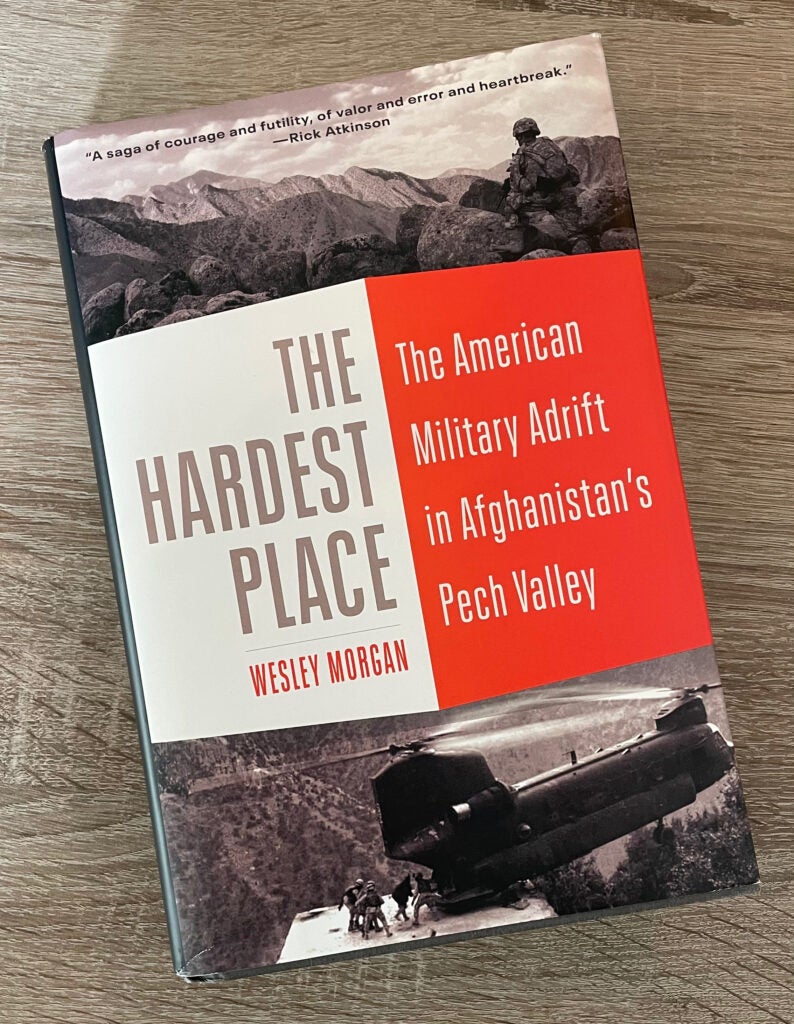
The problems Kunar’s terrain posed came into focus in the early fall of 2002, when the Joint Special Operations Command swung and missed in the most serious attempt the command had made to catch Osama bin Laden since his escape at Tora Bora.
If bin Laden was still in Afghanistan at all, it was hard to think of a place better suited to his needs than Kunar or its northern neighbor Nuristan, which mirrored the protective terrain of Tora Bora but on a much grander scale. It was a truism of the war in Kunar that no matter how high you went, there was always higher ground. Like Tora Bora, the craggy slopes of Kunar and Nuristan were thickly wooded. Between the conifer forests and the mind-bogglingly steep mountainsides, there were almost no clearings big enough for helicopters to land anywhere near the remote villages that dotted the slopes of Kunar’s canyon-like side valleys. And while you couldn’t see helicopters until they were right on top of you in the deep blackness of a rural Afghan night, in the narrow valleys of Kunar you could hear them a long way out, the thump of rotors echoing off the valley walls. It was one of the first things that the Delta Force reconnaissance commander Maj. Tom Greer had thought when he visited the SEALs he’d sent to set up the firebase south of Asadabad that first spring after September 11: Terrible place for helicopters.
Over the summer, more Americans had arrived at the Asadabad firebase. Fresh SEAL Team 6 and Delta Force operators replaced the original Advanced Force Operations team, rotating in from Bagram for a few weeks at a time. “We did a lot of armed recons, checking out this valley or that valley in pickup trucks,” remembered the Delta Force troop commander, a young officer with no idea he would tread the exact same ground 16 years later, as a brigadier general visiting a base still in use in 2018 by Afghan troops and their U.S. advisers. A handful of CIA officers and contractors took over one of the base’s buildings, and a Green Beret team joined them to help the agency set up a unit of armed Afghans called a Counterterrorism Pursuit Team.
The biggest addition, crammed into green tents in the courtyard, was a company of more than a hundred young infantrymen from the 75th Ranger Regiment. Rangers were a JSOC task force’s brawn; in Kunar in 2002, the Rangers’ job was to bail the small Delta and SEAL Team 6 recon teams out of trouble and, when one of those units launched a raid, to set up blocking positions to prevent anyone from getting away.
For the Rangers, life at the Asadabad base was quiet and hot. One Ranger platoon leader, lacking an interpreter, talked to local people in Russian. When the Rangers ventured north into the city on patrols, they, like the teenage Soviet draftees who had come before them, marveled at the frowning, red-faced rhesus monkeys sold as pets in the dusty bazaar. Some adopted a monitor lizard as a mascot until their commander made them get rid of it.

The only luxuries were coffee and a makeshift gym area, which the young infantrymen collaborated with the older JSOC operators and Green Berets to improve. There were downsides, like the dust, which necessitated the constant cleaning and re-cleaning of M4 rifles, and the lack of bathroom facilities, which required stirring barrels full of human waste while they burned. The upsides: being away from Bagram and the chiding superiors there, the thrill of driving Humvees up mountain roads far too narrow for them, and the possibility, however slim, of a firefight. “From a private’s perspective, it was delightful,” said one junior Ranger who was there that summer. “It felt like we were at the far end of the earth, which was every- thing we wanted—like we were in Indian country and any day some horde might descend on us. It was like, ‘This is what I signed up for.’”
The alert for the big mission came as the heat and rain of the summer were starting to subside and the nights were growing cold. According to one of the CIA’s informants, a group of Arab escapees from Tora Bora was holed up in a mountainside village high in the Shigal valley, ten miles north of Asadabad. The Shigal had been the scene of an unsuccessful CIA Predator strike in the spring, and the agency believed that the old mujahidin commander who controlled the valley, Haji Kashmir Khan, was harboring the Arabs there. Kashmir Khan’s foreign guests kept to themselves and bought a lot of bread, the source said; the local people didn’t know much about them and, because the foreigners spoke Arabic rather than Pashto, couldn’t communicate with them.
It wasn’t much, and a large Ranger force had already done an overnight hike up the Shigal in August and seen nothing unusual. But the report was the closest thing in months to a lead on bin Laden or Zawahiri, and it came from a source the CIA deemed reliable. At Fort Bragg, JSOC’s two-star commanding general, whose approval was required for risky operations, gave the “go” order.
The gears of the JSOC raiding machine started turning. A constellation of aircraft arrived in the skies above the Shigal: a spy plane to listen for enemy communications; a Predator, which beamed grainy infrared video back to Bagram and Fort Bragg; and then a wave of big twin-rotor MH-47 Chinook and smaller MH-60 Black Hawk helicopters, piloted by the elite Night Stalkers of the Army’s 160th Special Operations Aviation Regiment.

The “bearded men with green eyes,” as Afghan militants sometimes called U.S. special operators for the glowing dots of their night-vision goggles, slid down thick nylon ropes into their landing zones. The Chinooks deposited more than a hundred Rangers into forest clearings above the target. Black Hawks swooped downhill to drop off several dozen SEAL Team 6 operators “on the X,” or right in the village itself, but missed their mark and were unable to land; instead, another Chinook deposited a backup troop of SEALs on the target building, whose earth-covered roof was thick with the residents’ crops. The heavily equipped frogmen’s thin infrared aiming lasers swept every angle around them, bright green through their goggles but invisible to everyone else.
The Shigal mission was a “dry hole,” in military terminology— a disappointing miss. The SEALs found some guns and medical supplies in a cave nearby, but nothing else. The only shooting that participants in the mission remembered was a few desultory rounds as the helicopters first arrived, as likely fired by frightened farmers as by fleeing militants.

The unforgiving terrain almost brought the mission to grief as surely as enemy resistance might have, however. As the Rangers hiked down the mountain in the blackness, weighed down with heavy body armor vests that were completely inappropriate for the terrain and altitude, first one of them tumbled off a cliff, then a second, then a third. One broke a femur and had to be medevaced. “It was the most rugged terrain I’ve ever seen,” a Ranger on the mission said. “Absolutely inhospitable.”
The Black Hawks that inserted the SEALs could carry only a few operators apiece in the thin mountain air, and even then flying at that altitude was precarious for the single-rotor helicopters. During the first, abortive insertion attempt, one of the aircraft lost power. “You lose lift and there’s no recovering from it at that altitude,” said a Ranger officer who was watching the Predator feed at Bagram as the Black Hawk dropped suddenly and then slammed into the valley floor. For a moment it seemed as if it could be a complete disaster, but, amazingly, the pilot managed to make a “hard landing”— essentially a controlled crash. “It was like the hand of God was involved,” the Ranger watching from Bagram remembered. No one aboard was seriously hurt, but the helicopter’s rotor blades were too badly damaged for it to fly. That meant that instead of leaving before daylight, the JSOC raid force was stuck there, guarding the wreck until another Chinook could fly up and haul the crippled Black Hawk out.
As the Rangers piled into Humvees at the bottom of the mountain later that day for the ride back to Asadabad, boys from a nearby school ran out to meet them, rightly expecting that the American troops would throw them candy, pens, and MREs. One child produced a drawing that he waved close enough for some of the Rangers to see. In crayon, crude but clear, the boy had sketched a big twin-rotor helicopter hauling out a smaller single-rotor bird under its belly.
Few places in Afghanistan or Iraq would challenge the pilots of the 160th SOAR and their aircraft the way Kunar and Nuristan did. “When I came over that ridge, even under goggles, even with an [infrared] searchlight on, that terrain was unbelievable,” recalled one of the Night Stalker pilots on the mission, who would go on to take part in the mission that really did get bin Laden almost nine years later. “That area is the absolute worst. Down toward Khost, Gardez, Kandahar, the enemy is your problem, but up in Kunar it was always the terrain.”
Reprinted from THE HARDEST PLACE: The American Military Adrift in Afghanistan’s Pech Valley Copyright © 2021 by Wesley Morgan. Published by Random House, an imprint and division of Penguin Random House LLC.
The post How American troops got stuck fighting in Afghanistan’s ‘Hardest Place’ appeared first on Task & Purpose.
